Spatial Distribution Characteristics of Droplet Size and Velocity in a Methanol Spray
Abstract
1. Introduction
2. Experimental Setup
2.1. Experimental System
2.2. PIA System
2.3. Spray Slicer
2.4. Test Locations and Procedure
3. Results and Discussion
3.1. Microscopic Spray Structure
3.2. Droplet Size Distribution
3.3. Droplet Velocity Distribution
3.4. Spatial Distributions of Droplet Size and Velocity
4. Conclusions
Author Contributions
Funding
Data Availability Statement
Conflicts of Interest
References
- Ren, G.; Cui, M.; Yu, H.; Fan, X.; Zhu, Z.; Zhang, H.; Dai, Z.; Sun, J.; Yang, B.; Du, D. Global Environmental Change Shifts Ecological Stoichiometry Coupling Between Plant and Soil in Early-Stage Invasions. J. Soil Sci. Plant Nutr. 2024, 24, 2402–2412. [Google Scholar] [CrossRef]
- Feng, Y.; Wang, N.; Xie, H.; Li, J.; Li, G.; Xue, L.; Fu, H.; Feng, Y.; Poinern, G.E.J.; Chen, D. Livestock manure-derived hydrochar is more inclined to mitigate soil Global Warming Potential than raw materials based on soil stoichiometry analysis. Biol. Fertil. Soils 2023, 59, 459–472. [Google Scholar] [CrossRef]
- Yan, H.; Acquah, S.J.; Zhang, J.; Wang, G.; Zhang, C.; Darko, R.O. Overview of modelling techniques for greenhouse microclimate environment and evapotranspiration. Int. J. Agric. Biol. Eng. 2021, 14, 1–8. [Google Scholar] [CrossRef]
- Nazir, M.J.; Li, G.; Nazir, M.M.; Zulfiqar, F.; Siddique, K.H.M.; Iqbal, B.; Du, D. Harnessing soil carbon sequestration to address climate change challenges in agriculture. Soil. Tillage Res. 2024, 237, 105959. [Google Scholar] [CrossRef]
- Chauhdary, J.N.; Li, H.; Ragab, R.; Rakibuzzaman, M.; Khan, A.I.; Zhao, J.; Akbar, N. Climate Change Impacts on Future Wheat (Triticum aestivum) Yield, Growth Periods and Irrigation Requirements: A SALTMED Model Simulations Analysis. Agronomy 2024, 14, 1484. [Google Scholar] [CrossRef]
- Pan, S.; Zabed, H.M.; Wei, Y.; Qi, X. Technoeconomic and environmental perspectives of biofuel production from sugarcane bagasse: Current status, challenges and future outlook. Ind. Crops Prod. 2022, 188, 115684. [Google Scholar] [CrossRef]
- Hassan, G.; Shabbir, M.A.; Ahmad, F.; Pasha, I.; Aslam, N.; Ahmad, T.; Rehman, A.; Manzoor, M.F.; Inam-Ur-Raheem, M.; Aadil, R.M. Cereal processing waste, an environmental impact and value addition perspectives: A comprehensive treatise. Food Chem. 2021, 363, 130352. [Google Scholar] [CrossRef]
- Shanbhag, M.M.; Mishra, S.; Shetti, N.P.; Pollet, B.G.; Kalanur, S.S. Exploring the role of saline water splitting in sustainable energy solutions and hydrogen economy. Appl. Energy 2025, 389, 125733. [Google Scholar] [CrossRef]
- Shao, S.; Sun, T.; Li, X.; Wang, Y.; Ma, L.; Liu, Z.; Wu, S. Preparation of heavy bio-oil-based porous carbon by pyrolysis gas activation and its performance in the aldol condensation for aviation fuel as catalyst carrier. Ind. Crops Prod. 2024, 218, 118963. [Google Scholar] [CrossRef]
- Chu, W.; Li, H.; Liu, Y.; Zhou, B.; Luo, H.; Kim, W. Three-dimensional simulation analysis of in-cylinder combustion in space in-orbit hydrogen–oxygen internal combustion engine. Appl. Therm. Eng. 2025, 263, 125391. [Google Scholar] [CrossRef]
- Shao, S.; Ma, L.; Li, X.; Zhang, H.; Xiao, R. Preparation of activated carbon with heavy fraction of bio-oil from rape straw pyrolysis as carbon source and its performance in the aldol condensation for aviation fuel as carrier. Ind. Crops Prod. 2023, 192, 115912. [Google Scholar] [CrossRef]
- Chen, X.; Kitts, D.D.; Ji, D.; Ding, J. Free radical scavenging activities of phytochemical mixtures and aqueous methanolic extracts recovered from processed coffee leaves. Int. J. Food Sci. Technol. 2019, 54, 2872–2879. [Google Scholar] [CrossRef]
- Kiouranakis, K.I.; de Vos, P.; Zoumpourlos, K.; Coraddu, A.; Geertsma, R. Methanol for heavy-duty internal combustion engines: Review of experimental studies and combustion strategies. Renew. Sustain. Energy Rev. 2025, 214, 115529. [Google Scholar] [CrossRef]
- Chen, J.; Wang, X.; Fan, W.; Liu, T.; Wang, Y.; Geng, W. Experimental study of NO emission in coal-methanol co-combustion under air-staged condition. J. Energy Inst. 2024, 117, 101835. [Google Scholar] [CrossRef]
- Chen, Z.; Chen, H.; Wang, L.; Geng, L.; Zeng, K. Parametric study on effects of excess air/fuel ratio, spark timing, and methanol injection timing on combustion characteristics and performance of natural gas/methanol dual-fuel engine at low loads. Energy Convers. Manag. 2020, 210, 112742. [Google Scholar] [CrossRef]
- Jin, C.; Ding, C.; Hu, J.; Geng, Z.; Li, X.; Dong, J.; Xu, T.; Liu, H. Study on the stability and properties of carbon neutral methanol in blends with diesel fuel. Fuel 2024, 374, 132453. [Google Scholar] [CrossRef]
- Kou, H.; Hu, W.; Li, T.; Duan, Q.; Yin, X.; Duan, H.; Zeng, K. Effects of injection timing on combustion and mixture formation of a methanol direct injection engine equipped with a small volume passive pre-chamber. Fuel 2025, 384, 133910. [Google Scholar] [CrossRef]
- Yu, J.; Zhou, F.; Fu, J.; Huang, D.; Wu, C.; Liu, J. Research on the influence of injection strategies on the in-cylinder combustion process and emissions of methanol. Biomass Bioenergy 2024, 188, 107340. [Google Scholar] [CrossRef]
- Zhang, M.; Cao, J. Comparative study on combustion and emission characteristics of methanol/gasoline blend fueled DISI engine under different stratified lean burn modes. Fuel Process. Technol. 2024, 266, 108160. [Google Scholar] [CrossRef]
- Wang, X.; Liu, Y.; Li, X.; Jiang, B.; Xie, J.; Jin, Z.; Dou, H. Impact of dissociated methanol gas direct injection strategy on performance of port-injection methanol engines under dilution combustion condition. Energy 2025, 321, 135503. [Google Scholar] [CrossRef]
- Liu, H.; Yang, Y.; Zhou, Z.; Baig, A.; Liu, S.; Zhu, Z.; Wei, Y. Numerical investigation on the efficiency improvement and knock mitigation through combustion chamber optimization in a heavy-duty spark-ignition methanol engine with EGR. Appl. Therm. Eng. 2025, 264, 125469. [Google Scholar] [CrossRef]
- Yuan, B.; Zhao, H.; Huang, Y.; Zhang, M.; Song, Z.; Shen, Y.; Cheng, X.; Wang, Z. Investigation on cold start issues of methanol engines and its improvement from the perspective of droplet evaporation. Fuel 2025, 380, 133249. [Google Scholar] [CrossRef]
- Liu, J.; Liu, X.; Zhu, X.; Yuan, S. Droplet characterisation of a complete fluidic sprinkler with different nozzle dimensions. Biosyst. Eng. 2016, 148, 90–100. [Google Scholar] [CrossRef]
- Jiang, Y.; Chen, C.; Li, H.; Xiang, Q. Influences of nozzle parameters and low-pressure on jet breakup and droplet characteristics. Int. J. Agric. Biol. Eng. 2016, 9, 22–32. [Google Scholar]
- Liu, J.; Yuan, S.; Darko, R.O. Characteristics of water and droplet size distribution from fluidic sprinklers. Irrig. Drain. 2016, 65, 522–529. [Google Scholar] [CrossRef]
- He, C.; Zhu, F.; Chen, H.; Ji, H.; He, Z. Enhancement of liquid sheet breakup and atomization for spinning jet–jet impingement. Phys. Fluids 2025, 37, 022141. [Google Scholar] [CrossRef]
- Liao, J.; Luo, X.; Wang, P.; Zhou, Z.; O’Donnell, C.C.; Zang, Y.; Hewitt, A.J. Analysis of the Influence of Different Parameters on Droplet Characteristics and Droplet Size Classification Categories for Air Induction Nozzle. Agronomy 2020, 10, 256. [Google Scholar] [CrossRef]
- Feng, Z.; Yang, Z.; Jin, Y.; Si, Z.; He, Z. Experimental study on dribbling characteristics of gasoline/biodiesel blends after the end-of-injection. Int. J. Eng. Res. 2023, 25, 1053–1068. [Google Scholar] [CrossRef]
- Lai, S.; Zhong, W.; Jiang, Z.; Pachiannan, T.; Wang, W.; Wang, C.; Zhang, L.; He, Z. Study on the microscopic characteristics of pentanol/highly active fuel spray based on high-speed droplet tracking velocimetry technology. Exp. Therm. Fluid Sci. 2024, 159, 111279. [Google Scholar] [CrossRef]
- Jin, Y.; Zhang, Y.; Dong, P.; Zhai, C.; Nishida, K.; Yang, W.; Leng, X. Diesel spray characteristics of multi-hole injectors under geometrical similarity condition. At. Sprays 2025, 35, 19–45. [Google Scholar] [CrossRef]
- Wang, X.; Chang, X.; Liu, J.; Gao, J.; Wu, J.; He, H. Experimental investigation of high-pressure methanol spray characteristics for engines. Appl. Therm. Eng. 2025, 271, 126388. [Google Scholar] [CrossRef]
- Li, X.; Xiang, L.; Wang, L.; Wang, Z.; Hu, Y. Experimental study on macroscopic and microscopic characteristics of flash boiling methanol spray under extremely cold conditions. Energy Convers. Manag. 2025, 333, 119780. [Google Scholar] [CrossRef]
- Leng, X.; Xing, M.; Luo, Z.; Jin, Y.; He, Z.; Wei, S. An investigation on methanol high pressure spray characteristics and their predictive models. Energy 2024, 313, 133732. [Google Scholar] [CrossRef]
- Chen, R.; Li, H.; Wang, J.; Guo, X. Analysis of Droplet Characteristics and Kinetic Energy Distribution for Fixed Spray Plate Sprinkler at Low Working Pressure. Trans. ASABE 2021, 64, 447–460. [Google Scholar] [CrossRef]
- Gong, C.; Kang, C.; Jia, W.; Yang, W.; Wang, Y. The effect of spray structure of oil-based emulsion spray on the droplet characteristics. Biosyst. Eng. 2020, 198, 78–90. [Google Scholar] [CrossRef]
- Jiang, Y.; Liu, J.; Li, H.; Hua, L.; Yong, Y. Droplet distribution characteristics of impact sprinklers with circular and noncircular nozzles: Effect of nozzle aspect ratios and equivalent diameters. Biosyst. Eng. 2021, 212, 200–214. [Google Scholar] [CrossRef]
- Gouesbet, G.; Gréhan, G. Laser-based optical measurement techniques of discrete particles: A review [invited keynote]. Int. J. Multiph. Flow. 2015, 72, 288–297. [Google Scholar] [CrossRef]
- Jing, D.; Zhang, F.; Li, Y.; Xu, H.; Shuai, S. Experimental investigation on the macroscopic and microscopic spray characteristics of dieseline fuel. Fuel 2017, 199, 478–487. [Google Scholar] [CrossRef]
- Mo, J.; Tang, C.; Li, J.; Guan, L.; Huang, Z. Experimental investigation on the effect of n-butanol blending on spray characteristics of soybean biodiesel in a common-rail fuel injection system. Fuel 2016, 182, 391–401. [Google Scholar] [CrossRef]
- Magnotti, G.M.; Genzale, C.L. Detailed assessment of diesel spray atomization models using visible and X-ray extinction measurements. Int. J. Multiph. Flow 2017, 97, 33–45. [Google Scholar] [CrossRef]
- Li, Y.; Ning, Z.; Lü, M. Experimental study on fusion and break-up motion after droplet collision. Chin. J. Chem. Eng. 2020, 28, 712–720. [Google Scholar] [CrossRef]
- Desantes, J.M.; García-Oliver, J.M.; Pastor, J.M.; Olmeda, I.; Pandal, A.; Naud, B. LES Eulerian diffuse-interface modeling of fuel dense sprays near- and far-field. Int. J. Multiph. Flow 2020, 127, 103272. [Google Scholar] [CrossRef]
- Liao, J.; Hewitt, A.J.; Wang, P.; Luo, X.; Zang, Y.; Zhou, Z.; Lan, Y.; O’Donnell, C. Development of droplet characteristics prediction models for air induction nozzles based on wind tunnel tests. Int. J. Agric. Biol. Eng. 2019, 12, 1–6. [Google Scholar] [CrossRef]
- Liu, J.; Zhu, X.; Yuan, S.; Liu, X. Droplet Motion Model and Simulation of a Complete Fluidic Sprinkler. Trans. ASABE 2018, 61, 1297–1306. [Google Scholar] [CrossRef]
- Qin, W.; Xue, X.; Cui, L.; Zhou, Q.; Xu, Z.; Chang, F. Optimization and test for spraying parameters of cotton defoliant sprayer. Int. J. Agric. Biol. Eng. 2016, 9, 63–72. [Google Scholar] [CrossRef]
- Luo, H.; Jin, Y.; Nishida, K.; Ogata, Y.; Yao, J.; Chen, R. Microscopic characteristics of impinging spray sliced by a cone structure under increased injection pressures. Fuel 2021, 284, 119033. [Google Scholar] [CrossRef]
- Wang, Z.; Xu, H.; Jiang, C.; Wyszynski, M.L. Experimental study on microscopic and macroscopic characteristics of diesel spray with split injection. Fuel 2016, 174, 140–152. [Google Scholar] [CrossRef]
- Anand, T.N.C.; Mohan, A.M.; Ravikrishna, R.V. Spray characterization of gasoline-ethanol blends from a multi-hole port fuel injector. Fuel 2012, 102, 613–623. [Google Scholar] [CrossRef]
- Kashdan, J.T.; Shrimpton, J.S.; Whybrew, A. A digital image analysis technique for quantitative characterisation of high-speed sprays. Opt. Lasers Eng. 2007, 45, 106–115. [Google Scholar] [CrossRef]
- Berg, T.; Deppe, J.; Michaelis, D.; Voges, H.; Wissel, S. Comparison of particle size and velocity investigations in sprays carried out by means of different measurement techniques. In Proceedings of the ICLASS’06, Kyoto, Japan, 27 August–1 September 2006. [Google Scholar]
- Kulkarni, A.P.; Deshmukh, D. Spatial drop-sizing in airblast atomization-an experimental study. At. Sprays 2017, 27, 949–961. [Google Scholar] [CrossRef]
- Feng, Z.; Zhai, C.; Si, Z.; Tang, C.; He, Z. Experimental study on spray microscopic characteristics in cross flow: Droplet morphology, statistics and breakup. At. Sprays 2022, 32, 51–69. [Google Scholar] [CrossRef]
- Feng, Z.; Zhan, C.; Tang, C.; Yang, K.; Huang, Z. Experimental investigation on spray and atomization characteristics of diesel/gasoline/ethanol blends in high pressure common rail injection system. Energy 2016, 112, 549–561. [Google Scholar] [CrossRef]
- Feng, Z.; Tong, S.; Tang, C.; Zhan, C.; Nishida, K.; Huang, Z. Decoupling the effect of surface tension and viscosity on spray characteristics under different ambient pressures: Near-nozzle behavior and macroscopic characteristics. At. Sprays 2019, 29, 629–654. [Google Scholar] [CrossRef]
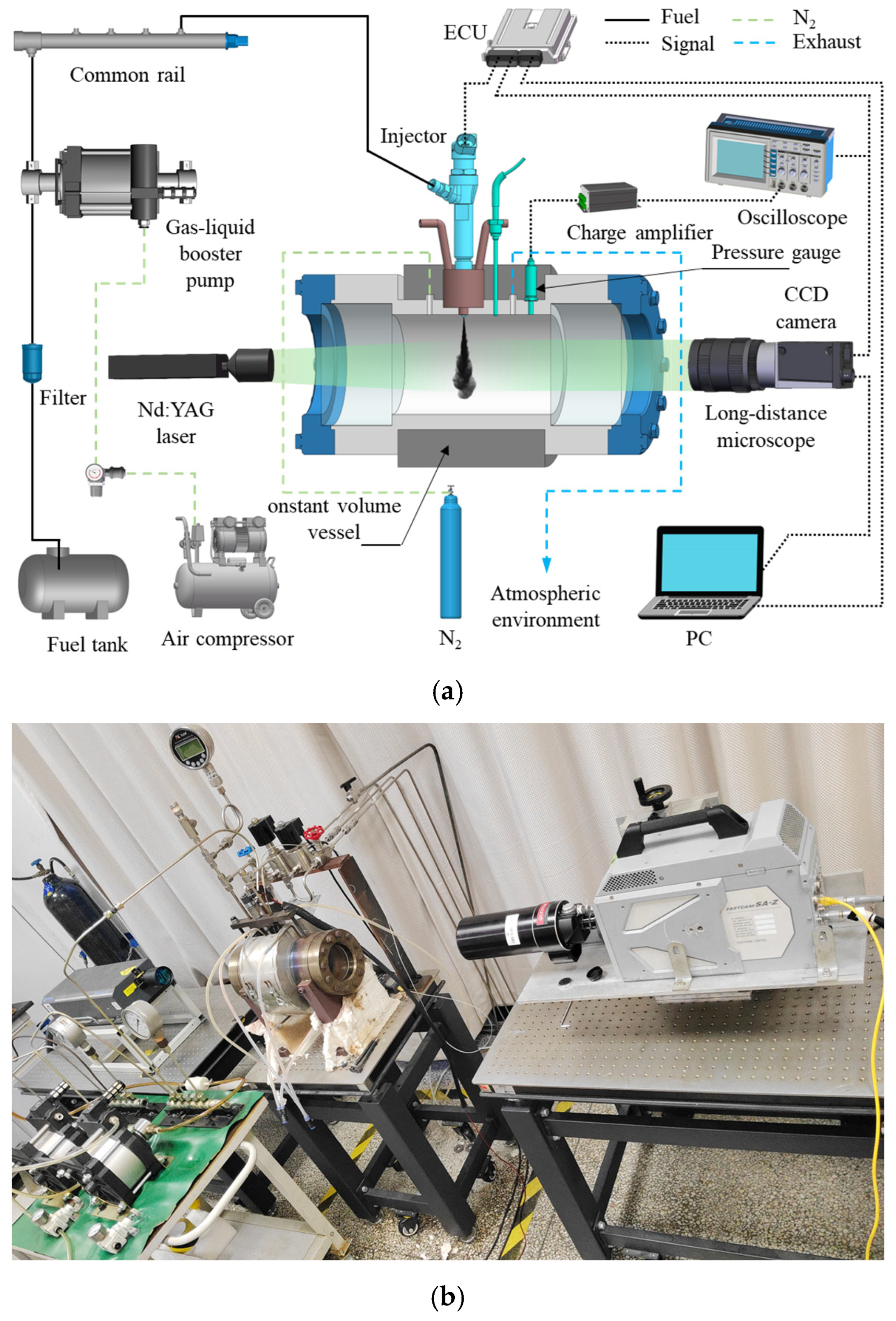

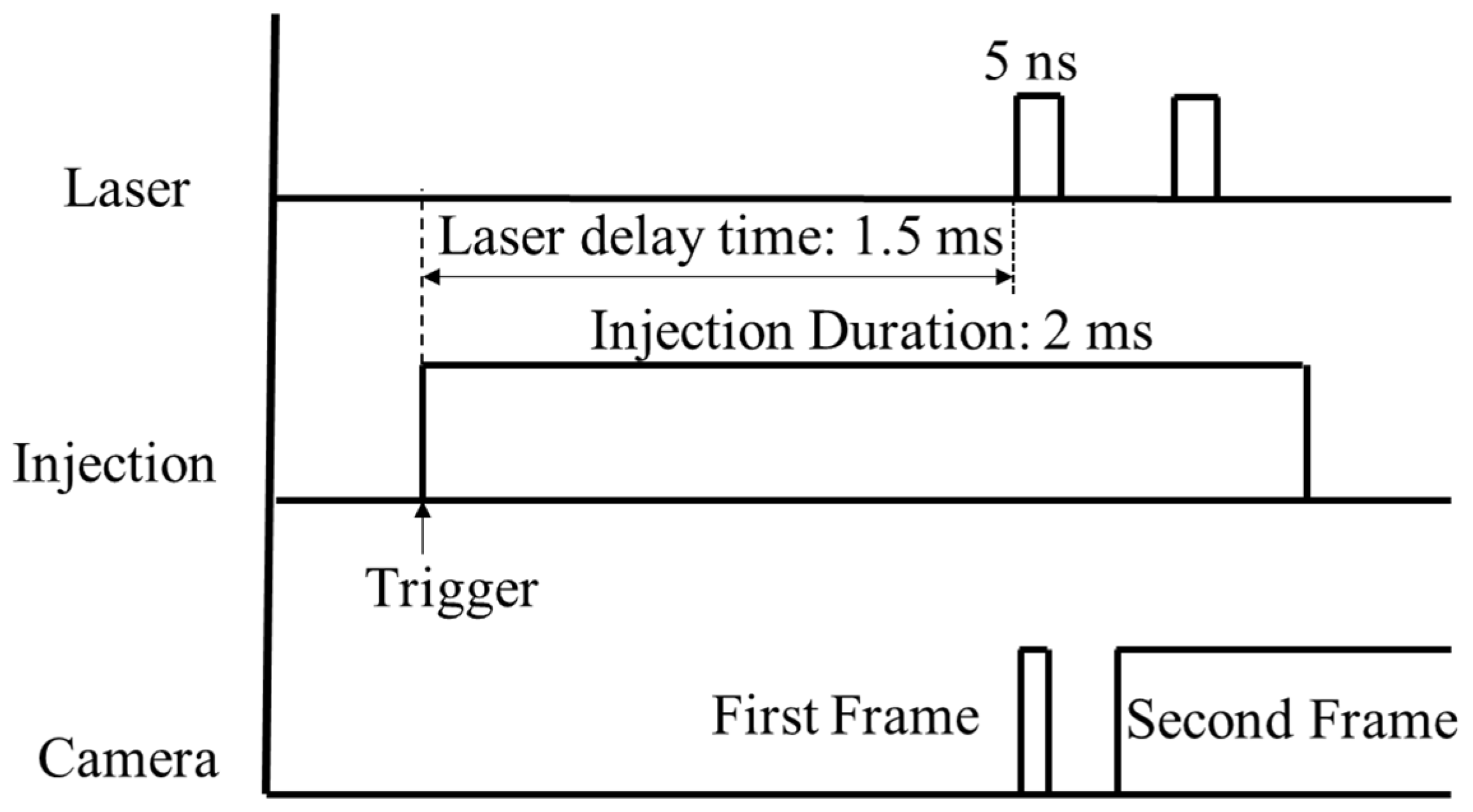



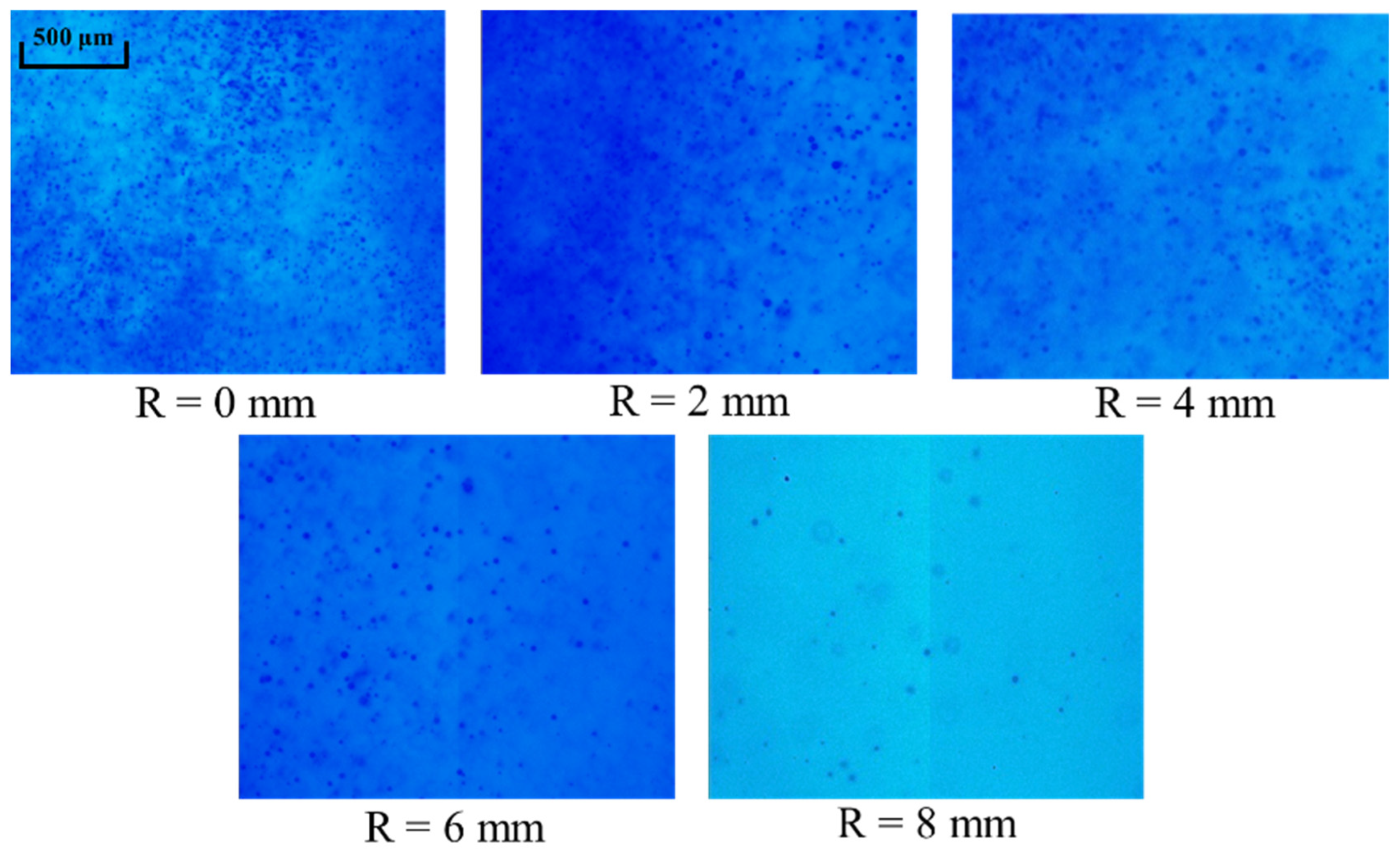
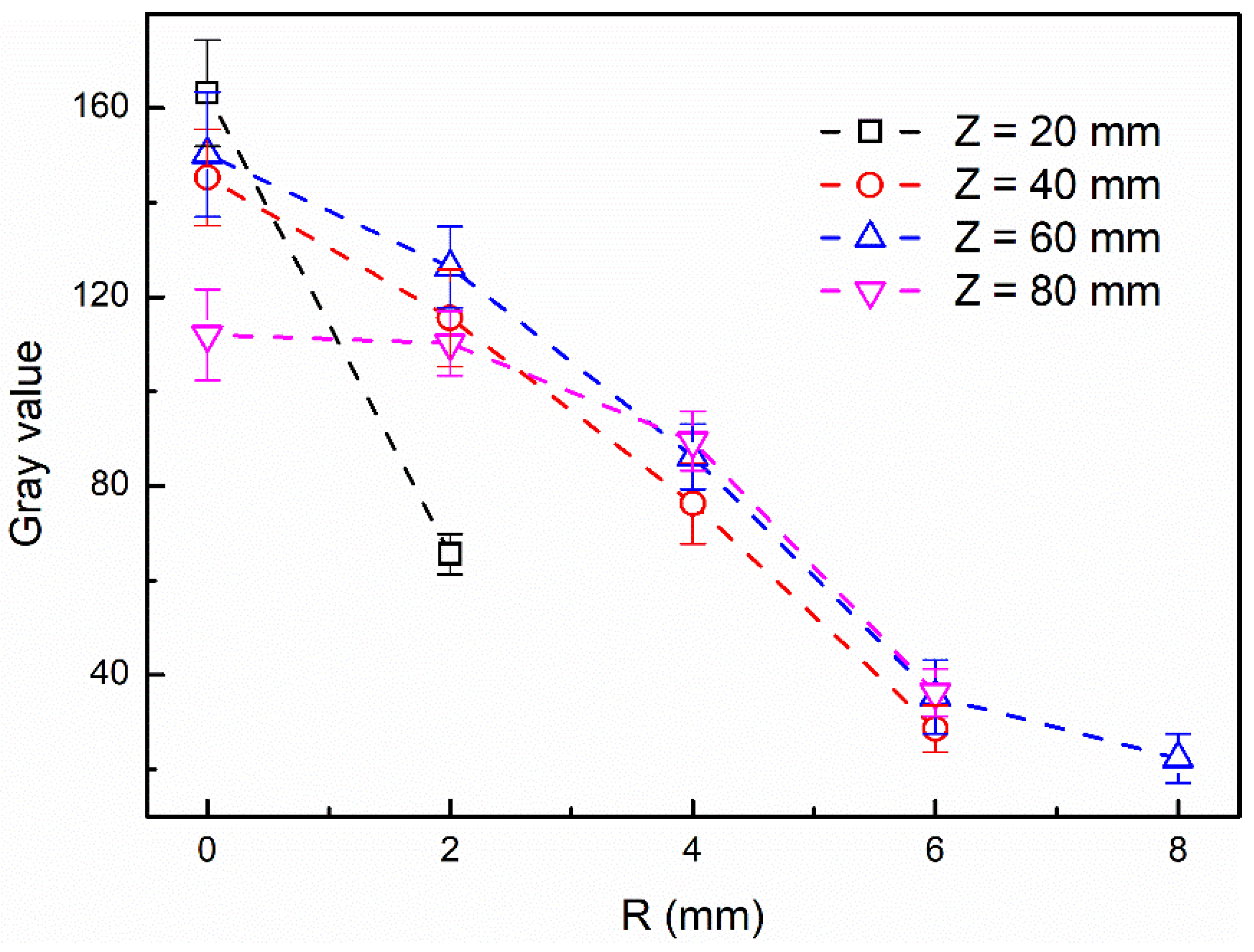
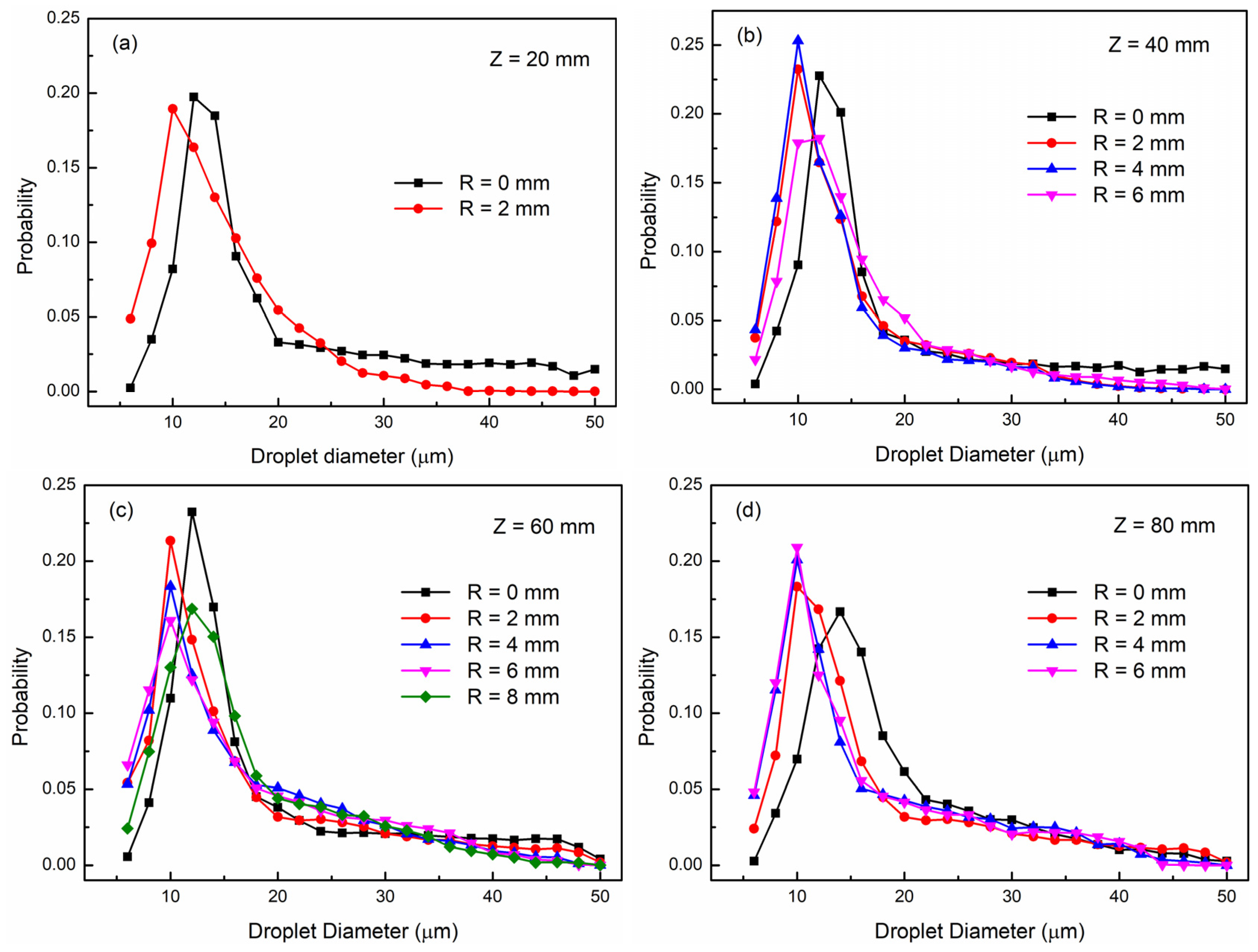
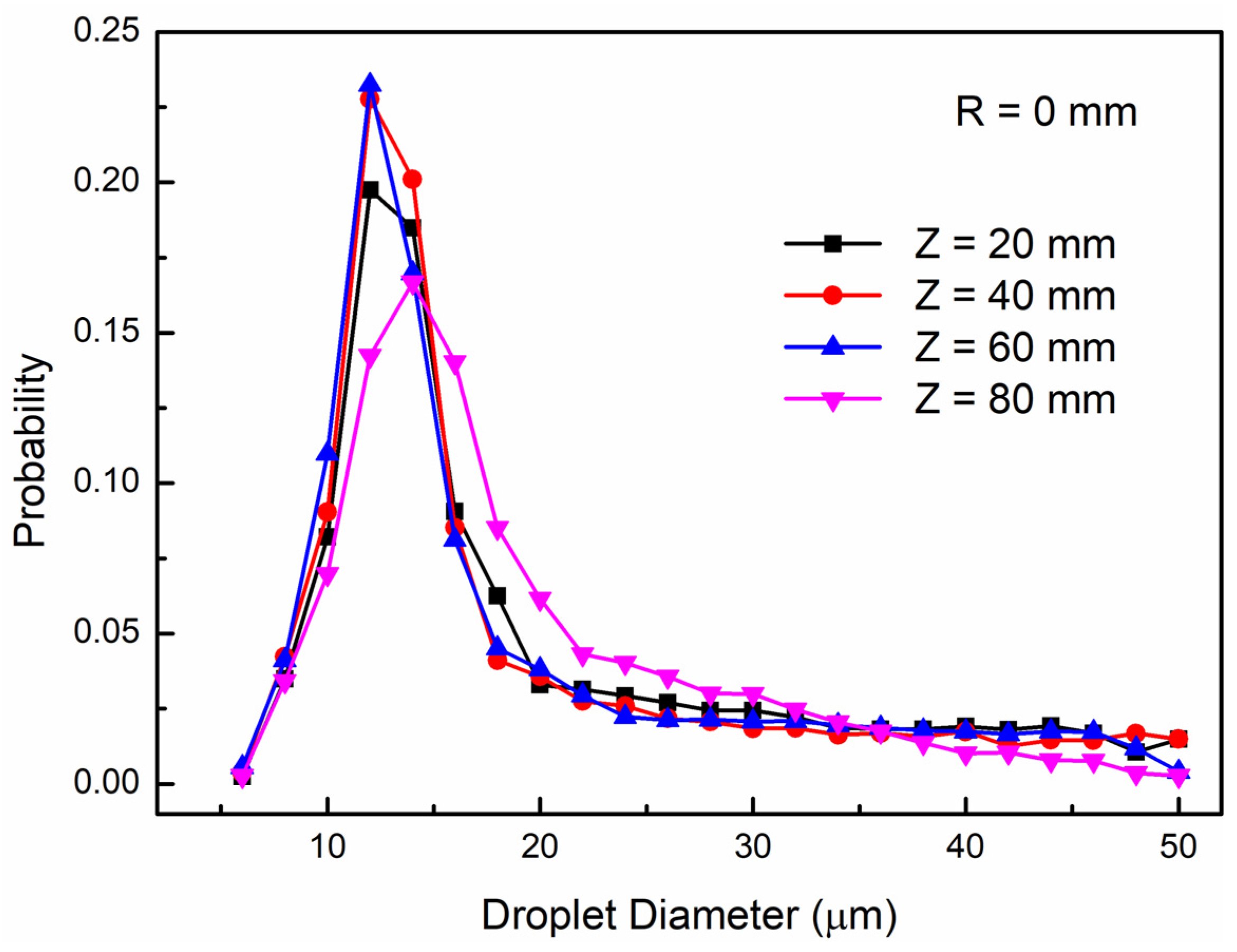
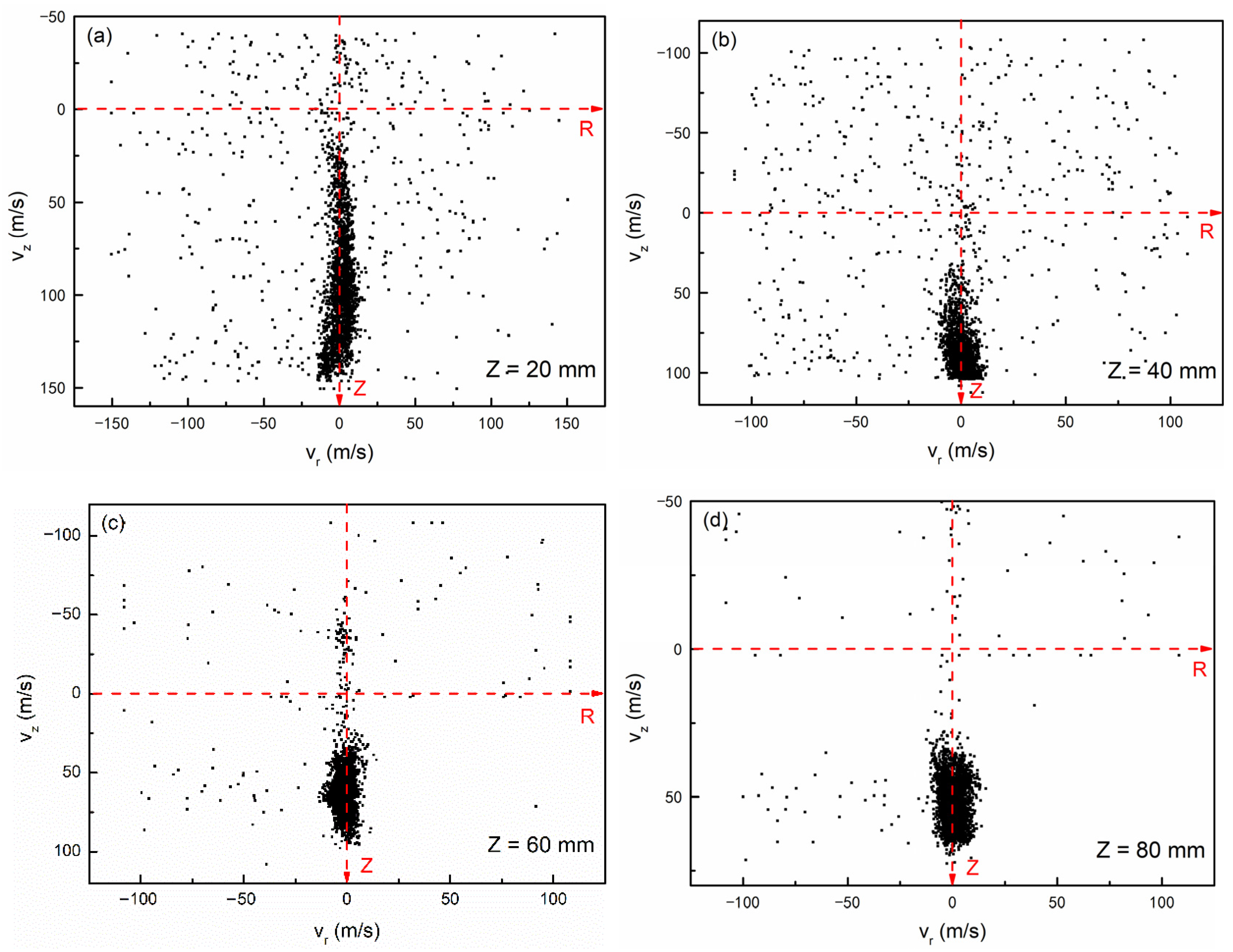
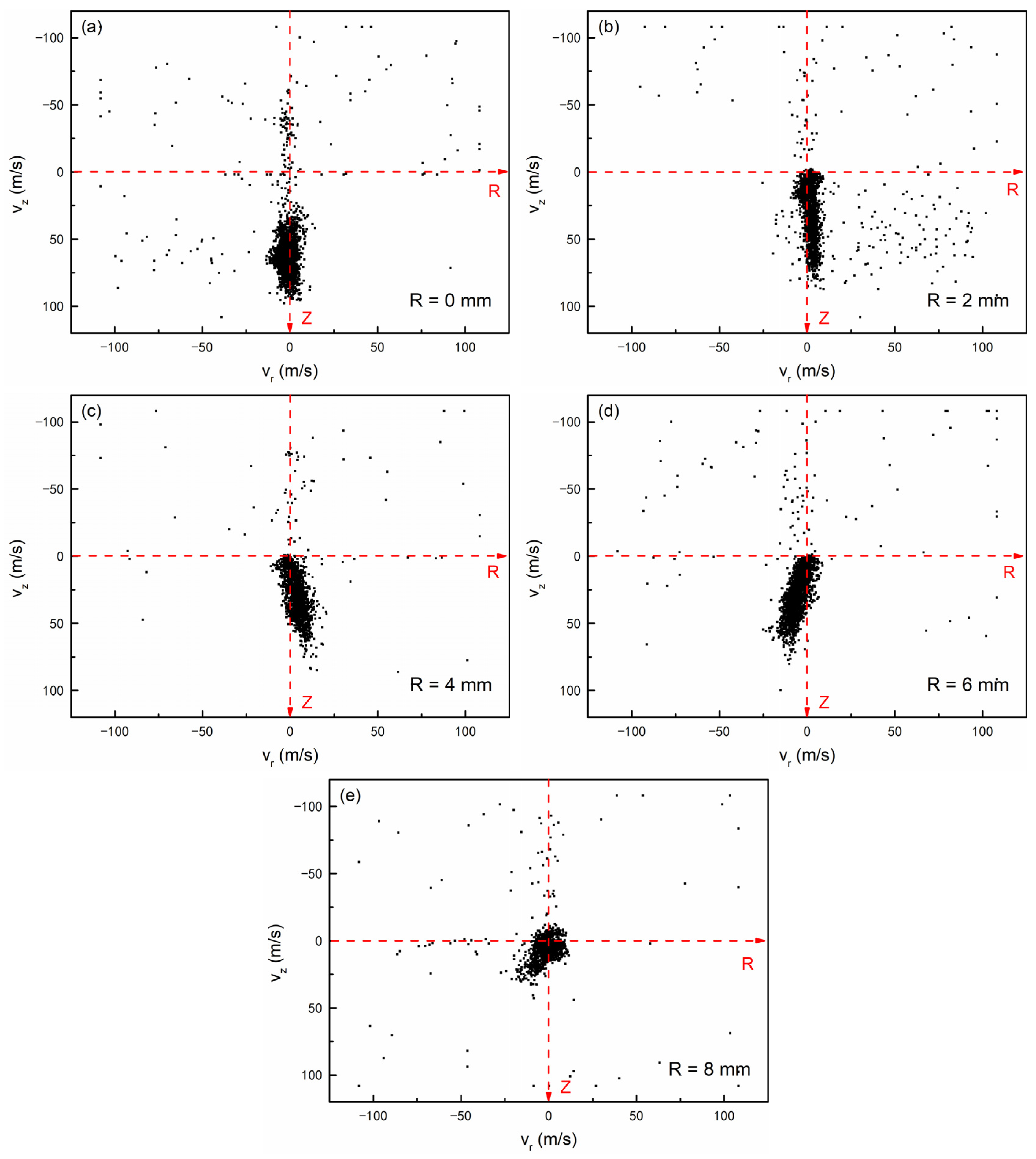
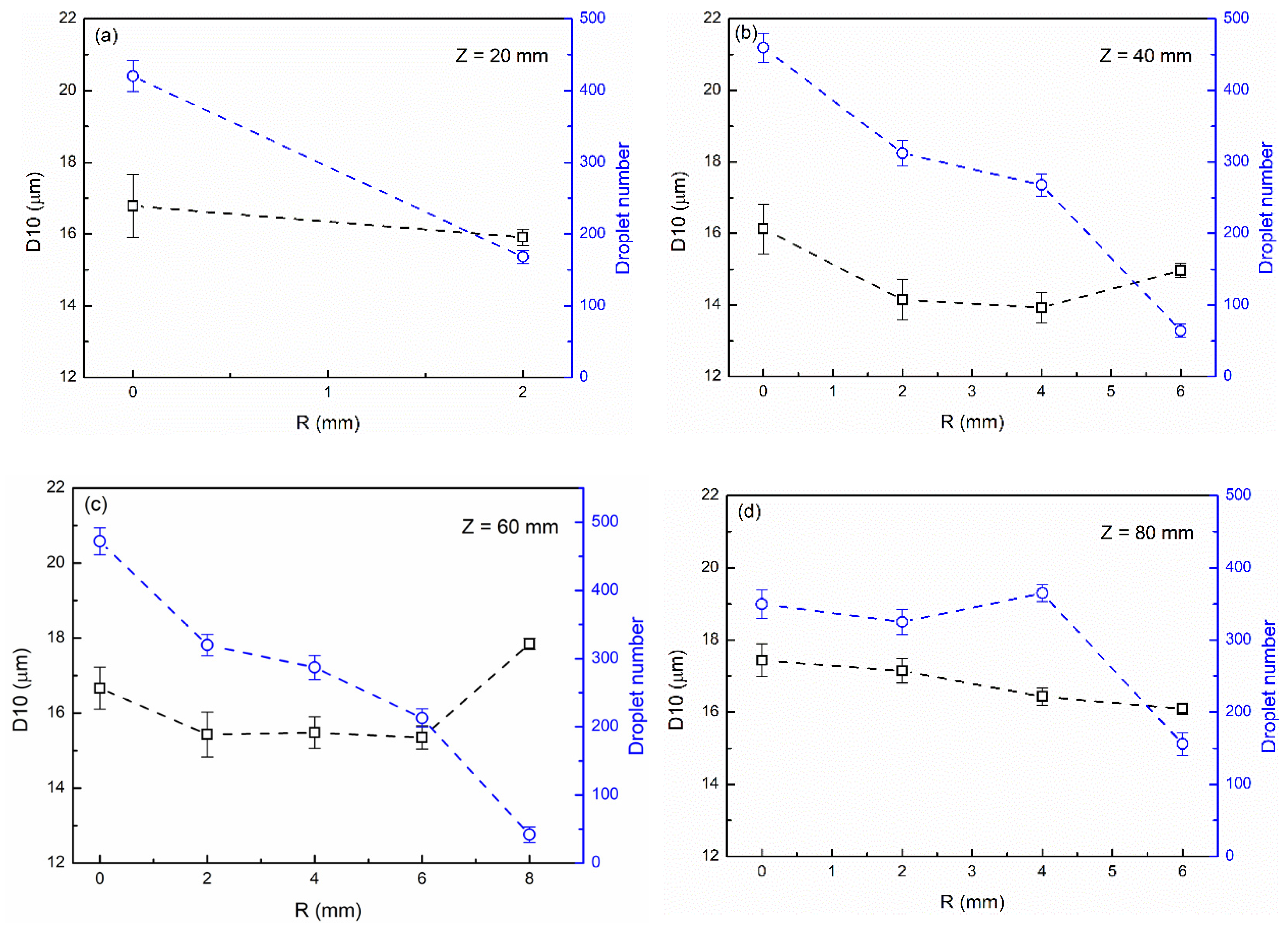


| Experimental Conditions | |
|---|---|
| Injector type | Single-hole fuel injector |
| Hole diameter (mm) | 0.14 |
| Injection pressure, Pinj (MPa) | 80 |
| Injection width (ms) | 2 |
| Ambient gas | Nitrogen |
| Ambient temperature, T (K) | 293 |
| Ambient pressure (MPa) | 2 |
| Image resolution (pixel) | 2456 × 2058 |
| Scaling factor (μm/pixel) | 0.81 |
| Tested fuel | Methanol |
| Fuel temperature (K) | 293 |
| Density (Kg/m3) | 790 |
| Dynamic viscosity (mPa·s) | 0.57 |
| Surface tension (mN/m) | 22.1 |
Disclaimer/Publisher’s Note: The statements, opinions and data contained in all publications are solely those of the individual author(s) and contributor(s) and not of MDPI and/or the editor(s). MDPI and/or the editor(s) disclaim responsibility for any injury to people or property resulting from any ideas, methods, instructions or products referred to in the content. |
© 2025 by the authors. Licensee MDPI, Basel, Switzerland. This article is an open access article distributed under the terms and conditions of the Creative Commons Attribution (CC BY) license (https://creativecommons.org/licenses/by/4.0/).
Share and Cite
Feng, Z.; Zhang, J.; Gu, J.; Jin, Y.; Tian, X.; He, Z. Spatial Distribution Characteristics of Droplet Size and Velocity in a Methanol Spray. Processes 2025, 13, 1883. https://doi.org/10.3390/pr13061883
Feng Z, Zhang J, Gu J, Jin Y, Tian X, He Z. Spatial Distribution Characteristics of Droplet Size and Velocity in a Methanol Spray. Processes. 2025; 13(6):1883. https://doi.org/10.3390/pr13061883
Chicago/Turabian StyleFeng, Zehao, Junlong Zhang, Jiechong Gu, Yu Jin, Xiaoqing Tian, and Zhixia He. 2025. "Spatial Distribution Characteristics of Droplet Size and Velocity in a Methanol Spray" Processes 13, no. 6: 1883. https://doi.org/10.3390/pr13061883
APA StyleFeng, Z., Zhang, J., Gu, J., Jin, Y., Tian, X., & He, Z. (2025). Spatial Distribution Characteristics of Droplet Size and Velocity in a Methanol Spray. Processes, 13(6), 1883. https://doi.org/10.3390/pr13061883








